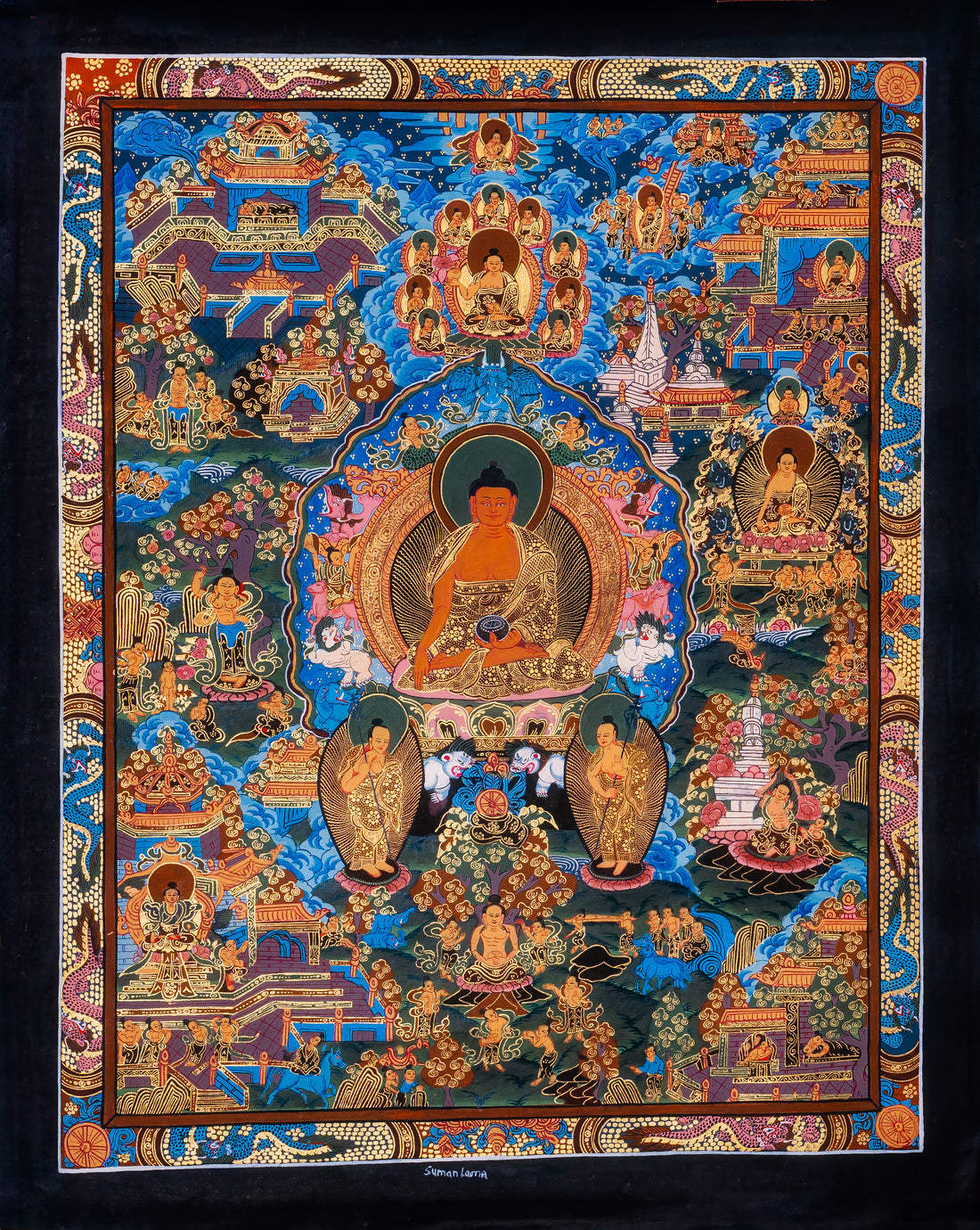
What is Thangka?
Share
Thangka, a captivating form of traditional Tibetan art, brings Buddhist philosophy and iconography vividly to life. But, it's more than mere art—these sacred objects serve as visual teachings and spiritual aids in meditation, rituals, and ceremonies.
What is thangka?
The word “thangka” itself means “something that one unrolls” in classic Tibetan, hinting at its practical, yet deeply spiritual, purpose. Created on cotton or silk appliqué, thangkas are often rolled up when not in use and displayed during specific practices or ceremonies.
What truly makes thangka unique is its intricate designs and radiant colors, which capture Buddhist deities, mandalas, and scenes from Buddha’s life in stunning detail.
Several materials like canvas, pigments, brocade and silk borders, pearls, coral, gold leaf, gesso, handmade brushes made from animal hair, etc are used for making a thangka painting. Together, these materials imbue thangka paintings with beauty, spiritual depth, and cultural resonance.
Some examples are: Mantra Mandala, Wheel of Life (Bhavachakra), Life of Buddhas, Green Tara, White Tara, etc.
History and Cultural Significance of Thangka
The origins of thangka painting date back to the 7th century, rooted deeply in Tibetan Buddhism. Thangkas were initially crafted as educational tools, helping monks and practitioners visualize the Buddha’s teachings and understand complex philosophies. Their evolution was influenced by the close cultural ties between Tibet and Nepal, sparking a vibrant exchange of artistic techniques and spiritual ideas. As Tibetan Buddhism spread, the demand for thangkas surged, leading to the growth of an art scene in Nepal.
Nepal’s Newar community, renowned for their artistry, quickly mastered the craft of creating intricate thangkas and other sacred artifacts. Their work became a fusion of skilled artistry and Buddhist devotion, resulting in uniquely crafted thangkas that carry deep cultural and spiritual significance. Over time, distinct regional styles emerged, with Tibetan and Nepali artisans infusing their own cultural perspectives into each piece.
Beyond religious practices, thangkas serve as symbols of Tibetan identity, resilience, and cultural pride. They stand as timeless artifacts of a culture under threat, preserving traditional values and narratives through each brushstroke. When visiting studios like Fine Thangka Art Gallery, you can witness how artisans today continue to practice this ancient craft, balancing traditional techniques with modern influences that keep the art form relevant.
What Makes Thangka Painting So Special?
Did you know that every painting has its own unique essence, making it impossible for any two to be truly identical?
Even when copies are made, each piece carries a distinct life and character that reflects the artist's individual expression.
Thangka painting isn’t just about aesthetics; it’s a journey of spiritual devotion. Each piece is meticulously created, sometimes taking months or even years to complete, as artists devote themselves to crafting every detail, from the complex patterns of mandalas to the serene expressions of deities. This dedication ensures that each thangka carries profound meaning, becoming a powerful visual meditation tool.
One of the remarkable aspects of thangka painting is the use of geometric precision and deep symbolism. Artists employ mathematical principles to maintain perfect proportions, creating visual harmony that reflects the spiritual truths the paintings embody.
Creating a thangka is a meditative experience for the artist, who enters a focused state, channeling spiritual energy into each brushstroke. This process transforms the artwork, infusing it with a vibrancy and energy that elevates it beyond conventional art.
These artworks, crafted with devotion and skill, serve as portals to deeper spiritual understanding, bridging ancient traditions with the modern world.
Significant Uses of Thangka Paintings
Thangkas are important to Tibetan Buddhism, serving as tools for meditation, learning, devotion, and cultural preservation, deeply woven into spiritual practice. Let's quickly dig deeper into the several uses of thangka paintings:
Meditation Purposes
Thangkas act as visual aids, allowing practitioners to immerse themselves in the delicate details as they focus on specific deities or spiritual symbols. As you gaze at a thangka, you create a mental image that deepens your connection to Buddhist teachings, enriching your meditative experience. This engaging practice transforms meditation into a vivid journey, making each session not just a routine, but a profound exploration of spirituality.
Teaching Tools
Thangkas vividly illustrate complex Buddhist philosophies, cosmology, and the lives of revered figures like the Buddha and Bodhisattvas. They break down intricate concepts into accessible visuals, making learning engaging and effective. So, they also serve as invaluable educational resources.
Whether it’s a monk guiding younger disciples or ordinary people delving into Buddhist teachings, thangkas simplify the spiritual journey, making it easier to grasp essential ideas and principles.
Devotional Objects
In the realm of devotion, thangkas hold a sacred place. Practitioners view these artworks as revered objects that symbolize respect for the deities they depict. It’s common to see individuals offering prayers, incense, and gifts to thangkas, creating a tangible connection with the divine. This act fosters a karmic bond that enhances one’s spiritual journey, allowing practitioners to feel closer to the profound teachings and guidance represented in the art.
Empowerment Ceremonies
During empowerment ceremonies, thangkas become powerful mediums for blessings from spiritual teachers or lamas. As practitioners focus on these sacred images, they visualize receiving blessings that enrich their spiritual lives. This immersive experience not only deepens devotion but also promotes personal growth, as individuals channel the transformative energy of the thangka into their spiritual practice.
Ritual and Ceremony Centerpieces
In Buddhist rituals and ceremonies, thangkas frequently take center stage, serving as focal points for communal worship. Displayed prominently, they help worshippers connect with the divine, creating a shared atmosphere of reverence and celebration. This communal engagement fosters a sense of unity among participants as they collectively honor the figures depicted in the thangkas, turning each ritual into a shared spiritual experience.
Cultural Preservation
As cultural treasures, thangkas capture the essence of Tibetan history, showcasing significant events, revered lamas, and traditional Buddhist narratives. They serve as visual archives that preserve the rich teachings, rituals, and heritage of Tibetan Buddhism for future generations. By maintaining this cultural legacy, thangkas play a crucial role in ensuring that the wisdom and artistry of Tibetan Buddhism continue to inspire and educate.
Commercial Use
With the rise of tourism in Tibetan and Nepalese regions, thangkas have found their way into the commercial market. While this shift has altered some aspects of their traditional religious role, these paintings remain cherished for their artistic beauty and cultural significance. Visitors and collectors alike appreciate thangkas not just as art pieces, but as windows into the rich tapestry of Tibetan spirituality and history, allowing them to take a piece of this vibrant culture home with them.
Conclusion
If you’re looking to purchase a thangka, at Fine Thangka Art Gallery, we create each thangka painting using gold, ensuring the highest quality and craftsmanship in every piece.
